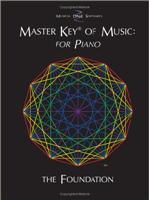 Hundreds of years ago the idea of standardized musical notation probably seemed quite confusing, especially to those not educated in the musical arts. Today we barely give music notation and the structures that make up our music a second thought. Perhaps we should, and the Master Key of Music for Piano attempts to do just that, change the way we think about music, how it is written, and how music is so tightly related to advanced mathematics.
Hundreds of years ago the idea of standardized musical notation probably seemed quite confusing, especially to those not educated in the musical arts. Today we barely give music notation and the structures that make up our music a second thought. Perhaps we should, and the Master Key of Music for Piano attempts to do just that, change the way we think about music, how it is written, and how music is so tightly related to advanced mathematics.
Master Key's Graphical Representation of Music In Three Dimensions
The premise behind the Master Key of Music seems to be that all music can be graphically represented in a kind of helix formation, spiraling up through the octaves of audible sound. This musical DNA sequence allows us to graph notes and chords along a long spiral staircase of notes with each octave notated in a fashion similar to a clock face. An "A" is at twelve noon, A-sharp is at one o'clock, and so on. By drawing lines between these tones one can graphically see the relationships that form major, minor, and all other types of chords.
Any three note triad forms a triangle when graphed in this way. The different chord types (major, minor, augmented, etc.) always form the same type of triangle no matter what the notes are that make them up. For example, an equilateral triangle denotes an augmented triad.
Visually Compelling, But How Do You Use it?
While it is somewhat fascinating to see music graphed in this very scientific, mathematical way this reviewer finds it very difficult to really grasp what this book is trying to teach other than that music is much more mechanically based than one tends to consider. The first sixty pages of the book are dedicated to teaching what Master Key is but the last several hundred are nothing more than graphical representations of every chord and scale that might be used in Western music. Granted, the illustrations are colorful and interesting to look at, but one has to wonder about any book that leaves the reader more puzzled than he was when he started reading. In short, The Master Key of Music is an interesting read and may actually have some application at the higher levels of music education but for the lay musician or for general music educators it is quite a different story indeed.
